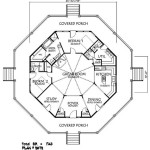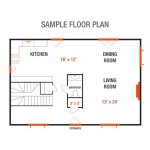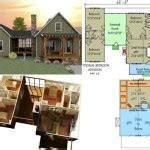A House Plan, also known as a Building Plan, or Construction Plan, refers to a set of detailed drawings and specifications that outlines the design, construction, and layout of a building, typically a house. It provides a visual representation of the building’s structure, including its dimensions, materials, and other key features.
House Plans serve as a blueprint for builders and contractors to construct a house according to the specified design. They include floor plans, elevations, sections, and other technical drawings that illustrate the building’s layout, room sizes, and exterior appearance. House Plans ensure that the building is constructed safely and efficiently, meeting building codes and regulations.
In the following sections, we will delve into the various elements of a House Plan, exploring its importance in the construction process and discussing the different types of House Plans available. We will also provide tips on choosing the right House Plan for your building project and highlight the benefits of using professional design services to create a customized and functional House Plan.
A House Plan, also known as a Building Plan or Construction Plan, is a set of detailed drawings and specifications that outlines the design, construction, and layout of a building, typically a house.
- Defines room sizes and shapes
- Indicates placement of windows and doors
- Shows location of plumbing and electrical
- Ensures building code compliance
- Serves as a blueprint for construction
- Helps estimate construction costs
- Facilitates communication between architects, builders, and clients
- Enhances energy efficiency and sustainability
- Provides a visual representation of the finished building
House Plans are essential for ensuring that a building is constructed safely, efficiently, and in accordance with the owner’s vision and requirements.
Defines room sizes and shapes
One of the most important functions of a House Plan is to define the sizes and shapes of the rooms within the building. This information is crucial for several reasons:
Space planning: The room sizes and shapes determine how the space within the building will be used. A well-designed House Plan will ensure that the rooms are large enough to accommodate their intended functions, while also maintaining a sense of balance and proportion throughout the building.
Furniture placement: The sizes and shapes of the rooms also influence the placement of furniture and other objects within the space. A House Plan will help to determine where furniture can be placed in a way that maximizes functionality and creates a comfortable and inviting atmosphere.
Traffic flow: The sizes and shapes of the rooms can also affect the flow of traffic through the building. A well-designed House Plan will ensure that there is sufficient space for people to move around comfortably, without feeling cramped or congested.
Overall aesthetic: The sizes and shapes of the rooms contribute to the overall aesthetic of the building. A House Plan that is well-proportioned and balanced will create a visually appealing and harmonious space.
Indicates placement of windows and doors
The placement of windows and doors in a House Plan is crucial for several reasons:
- Natural light and ventilation: Windows and doors allow natural light to enter the building, reducing the need for artificial lighting and creating a more inviting and healthy indoor environment. They also provide ventilation, allowing fresh air to circulate throughout the building and helping to regulate indoor temperature.
- Views and aesthetics: Windows and doors can frame beautiful views of the surrounding landscape, enhancing the overall aesthetic appeal of the building. They can also be used to create focal points and add architectural interest to the faade.
- Access and egress: Doors provide access to the building and allow people to move in and out. Windows can also be used as emergency exits, providing an additional means of escape in case of an emergency.
- Privacy and security: Windows and doors can be strategically placed to provide privacy for the occupants, while also allowing them to maintain a connection with the outdoors. Security features, such as locks and security bars, can be incorporated into the design to enhance the safety of the building.
Overall, the placement of windows and doors in a House Plan is a critical factor that affects the functionality, aesthetics, and overall quality of the building.
Shows location of plumbing and electrical
The location of plumbing and electrical systems is a critical aspect of a House Plan. These systems are essential for the functionality and comfort of the building, and their placement must be carefully planned to ensure that they are efficient, safe, and accessible.
The plumbing system includes pipes, fixtures, and appliances that supply water and drain waste throughout the building. The House Plan will indicate the location of water supply lines, drain lines, and plumbing fixtures, such as sinks, toilets, showers, and bathtubs. It will also show the location of the water heater and other mechanical equipment.
The electrical system includes wiring, outlets, and fixtures that provide power and lighting throughout the building. The House Plan will indicate the location of electrical panels, circuits, and outlets. It will also show the location of lighting fixtures, such as ceiling lights, wall sconces, and recessed lighting.
Proper placement of plumbing and electrical systems is essential for several reasons:
- Functionality: The plumbing and electrical systems must be located in a way that allows them to function efficiently and effectively. This means that pipes and wires should be routed in a logical and organized manner, and that fixtures and appliances should be placed in convenient locations.
- Safety: Plumbing and electrical systems can be hazardous if they are not installed properly. The House Plan will help to ensure that these systems are installed in a safe and code-compliant manner, minimizing the risk of leaks, fires, and other accidents.
- Accessibility: Plumbing and electrical systems require regular maintenance and repairs. The House Plan will help to ensure that these systems are accessible for maintenance personnel, making it easier to keep the building in good working order.
Ensures building code compliance
Building codes are regulations that govern the construction of buildings. These codes are in place to ensure that buildings are safe, habitable, and energy-efficient. House Plans must comply with all applicable building codes, which can vary depending on the location of the building.
The House Plan will show how the building will meet the requirements of the building code, including:
- Structural integrity: The House Plan will show how the building will be constructed to withstand the loads that it will be subjected to, such as wind, snow, and earthquakes.
- Fire safety: The House Plan will show how the building will be constructed to minimize the risk of fire, including the use of fire-resistant materials and the installation of smoke detectors and sprinklers.
- Energy efficiency: The House Plan will show how the building will be constructed to minimize energy consumption, including the use of energy-efficient appliances and lighting, and the installation of insulation and weatherstripping.
- Accessibility: The House Plan will show how the building will be constructed to be accessible to people with disabilities, including the installation of ramps, elevators, and accessible bathrooms.
By ensuring that the House Plan complies with all applicable building codes, the homeowner can be confident that their building will be safe, habitable, and energy-efficient.
In addition to ensuring compliance with building codes, House Plans can also help to streamline the building permit process. By submitting a House Plan that is already compliant with the building code, the homeowner can avoid delays and costly revisions during the permitting process.
Serves as a blueprint for construction
A House Plan serves as a blueprint for construction, providing a detailed guide for builders and contractors to follow during the construction process. It is the roadmap that ensures that the building is constructed according to the design intent and meets all applicable building codes and regulations.
The House Plan includes detailed drawings and specifications that outline every aspect of the building’s construction, including:
- Floor plans: Floor plans show the layout of each floor of the building, including the location of rooms, walls, doors, and windows.
- Elevations: Elevations show the exterior appearance of the building from different sides.
- Sections: Sections show the interior construction of the building, including the framing, insulation, and mechanical systems.
- Details: Details provide additional information about specific aspects of the construction, such as the type of materials to be used, the size of the framing members, and the installation methods.
The House Plan also includes a written specification that provides additional information about the materials and methods to be used in the construction process. The specification will typically include:
- Material specifications: The material specifications list the types of materials that are to be used in the construction of the building, including the grade of lumber, the type of roofing, and the type of siding.
- Construction methods: The construction methods section describes the methods that are to be used to construct the building, including the framing methods, the roofing methods, and the siding methods.
- Finishes: The finishes section describes the finishes that are to be applied to the building, including the paint colors, the flooring materials, and the countertops.
By following the House Plan and specification, builders and contractors can ensure that the building is constructed according to the design intent and meets all applicable building codes and regulations.
Helps estimate construction costs
A House Plan is essential for estimating the cost of construction. The Plan provides a detailed breakdown of the materials and labor required to build the house, which can be used to create a budget and secure financing.
The cost of construction can vary significantly depending on a number of factors, including the size of the house, the complexity of the design, and the materials used. A House Plan can help to estimate these costs by providing a detailed list of the materials and labor required.
The materials list will include all of the materials that will be used in the construction of the house, including lumber, concrete, roofing, siding, windows, and doors. The labor list will include all of the labor that will be required to build the house, including framing, roofing, siding, and finishing.
Once the materials and labor have been identified, the cost of each item can be estimated. This can be done by contacting suppliers and contractors to get quotes for the materials and labor. Once the cost of each item has been estimated, the total cost of construction can be calculated.
Having a detailed House Plan can help to ensure that the cost of construction is accurately estimated. This can help to avoid unexpected costs and delays during the construction process.
Facilitates communication between architects, builders, and clients
A House Plan is a critical tool for facilitating communication between architects, builders, and clients. It provides a shared visual representation of the design intent, allowing all parties to understand the project and work together effectively.
- Clear communication of design intent: The House Plan provides a clear and concise representation of the architect’s design intent. It allows all parties to visualize the finished building and understand the spatial relationships between different rooms and elements.
- Efficient coordination: The House Plan enables efficient coordination between the architect, builder, and client. It serves as a reference point for discussions, helping to avoid misunderstandings and ensuring that all parties are on the same page.
- Identification and resolution of issues: The House Plan can help to identify and resolve issues early in the design process. By reviewing the Plan, the builder and client can identify potential problems and work with the architect to find solutions before construction begins.
- Accurate cost estimation: The House Plan provides a basis for accurate cost estimation. By understanding the scope of the project and the materials required, the builder can provide a more accurate estimate of the construction costs.
Overall, the House Plan plays a vital role in facilitating effective communication between architects, builders, and clients. It helps to ensure that all parties have a clear understanding of the project, leading to a smoother and more successful construction process.
Enhances energy efficiency and sustainability
A well-designed House Plan can significantly enhance the energy efficiency and sustainability of a building. By incorporating energy-efficient features and sustainable design principles, the Plan can help to reduce energy consumption, lower utility bills, and minimize the building’s environmental impact.
- Optimized building envelope: The building envelope refers to the exterior surfaces of the building, including the walls, roof, and windows. A well-insulated and airtight building envelope can significantly reduce heat loss and heat gain, leading to lower energy consumption for heating and cooling.
- Energy-efficient windows and doors: Windows and doors are major sources of heat loss and heat gain in a building. Energy-efficient windows and doors are designed to minimize heat transfer, reducing the amount of energy required to maintain a comfortable indoor temperature.
- Passive solar design: Passive solar design techniques utilize the sun’s energy to heat and cool a building naturally. By strategically placing windows and skylights, and using thermal mass to store heat, a House Plan can maximize passive solar gain and reduce the need for mechanical heating and cooling systems.
- Renewable energy systems: House Plans can incorporate renewable energy systems, such as solar panels and geothermal heat pumps, to generate electricity and heat water. By utilizing renewable energy sources, a building can reduce its reliance on fossil fuels and minimize its carbon footprint.
Overall, a well-designed House Plan that incorporates energy-efficient features and sustainable design principles can create a building that is more comfortable, affordable to operate, and environmentally friendly.
Provides a visual representation of the finished building
One of the most important functions of a House Plan is to provide a visual representation of the finished building. This allows all parties involved in the construction process to understand the design intent and make informed decisions.
The House Plan includes detailed drawings that show the layout of the building, the dimensions of the rooms, and the placement of windows and doors. These drawings can be used to create a three-dimensional model of the building, which can help to visualize the finished product. This can be especially helpful for clients who may not be able to fully understand the design from two-dimensional drawings alone.
In addition to providing a visual representation of the finished building, the House Plan can also be used to identify potential problems and conflicts. For example, the Plan can be used to check for code compliance, to ensure that the building will be structurally sound, and to identify any potential conflicts between different building systems.
Overall, the House Plan is an essential tool for visualizing the finished building and ensuring that the construction process runs smoothly.
A House Plan is a valuable tool for both homeowners and builders. It can help homeowners to visualize their dream home and make informed decisions about the design. It can also help builders to construct the home efficiently and accurately.










Related Posts








